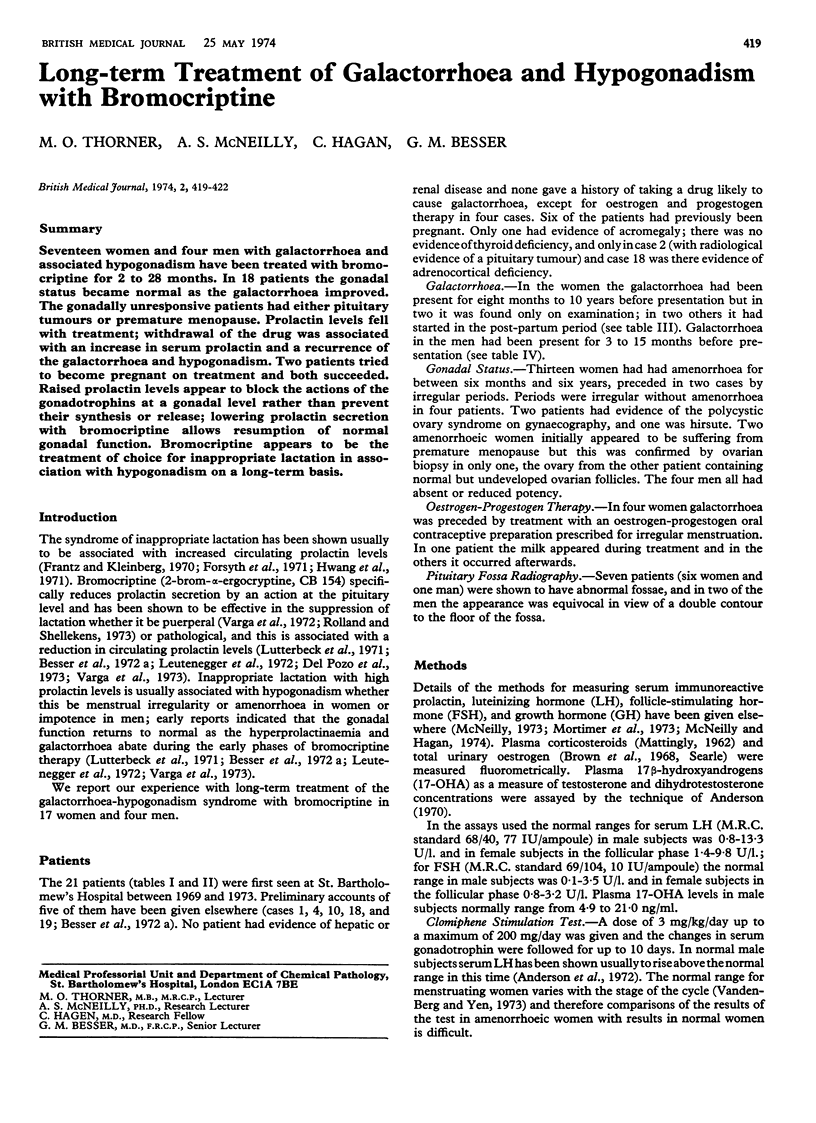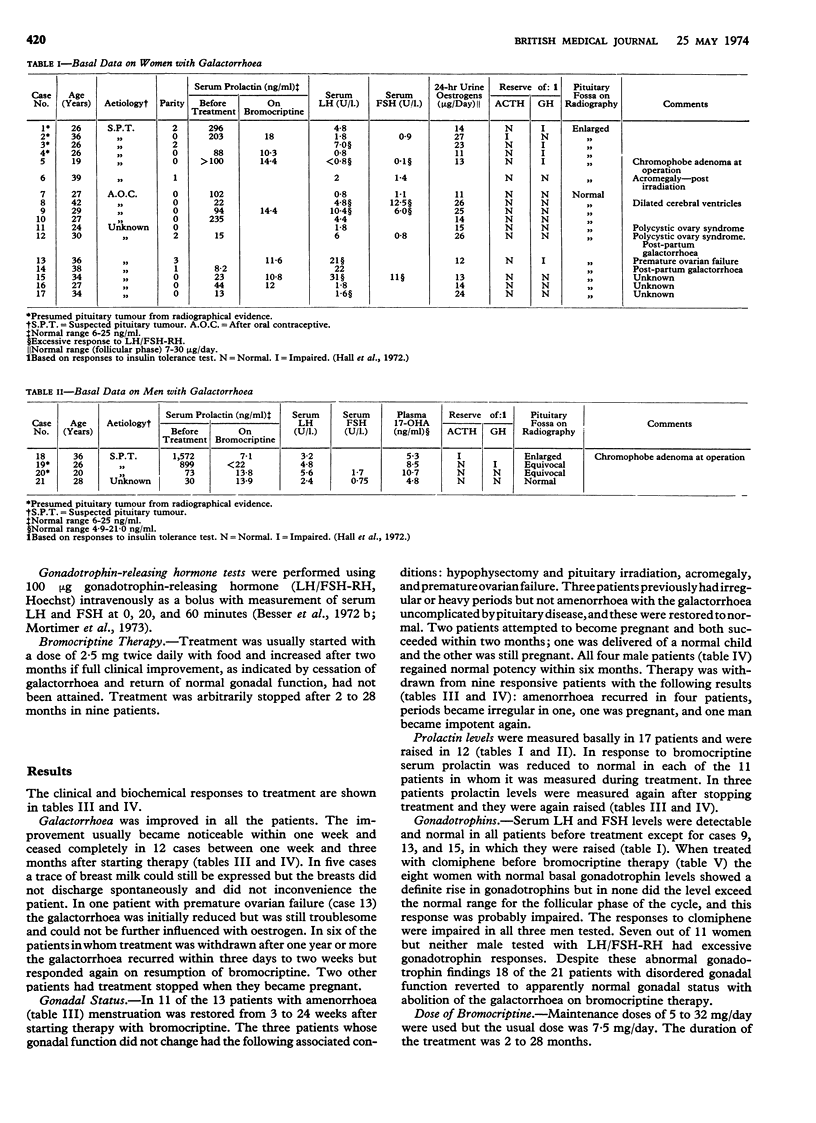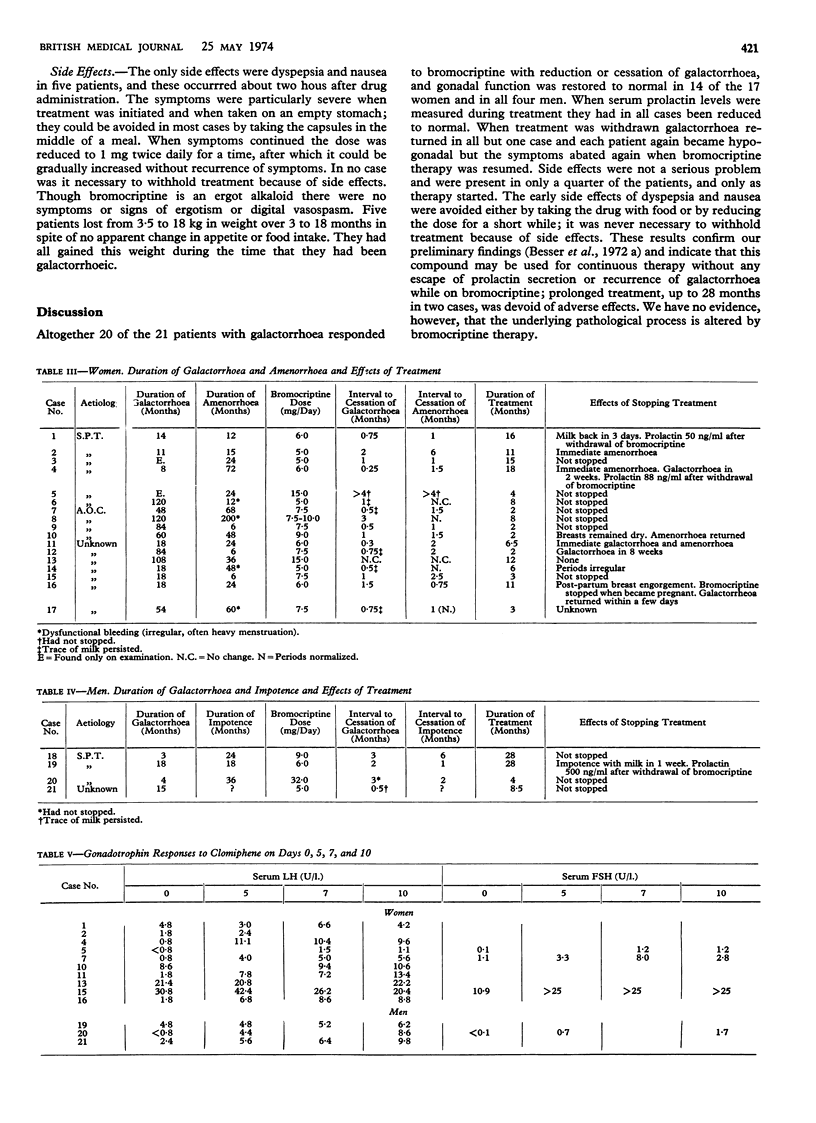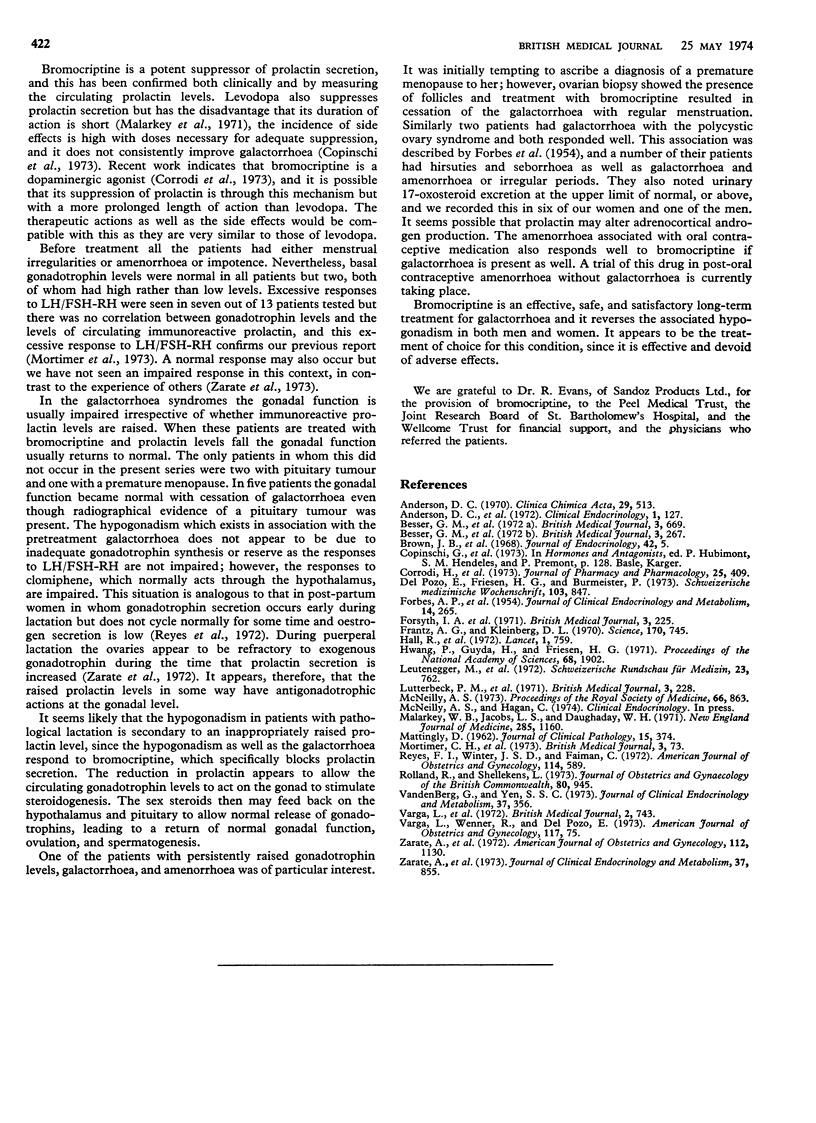Abstract
Seventeen women and four men with galactorrhoea and associated hypogonadism have been treated with bromocriptine for 2 to 28 months. In 18 patients the gonadal status became normal as the galactorrhoea improved. The gonadally unresponsive patients had either pituitary tumours or premature menopause. Prolactin levels fell with treatment; withdrawal of the drug was associated with an increase in serum prolactin and a recurrence of the galactorrhoea and hypogonadism. Two patients tried to become pregnant on treatment and both succeeded. Raised prolactin levels appear to block the actions of the gonadotrophins at a gonadal level rather than prevent their synthesis or release; lowering prolactin secretion with bromocriptine allows resumption of normal gonadal function. Bromocriptine appears to be the treatment of choice for inappropriate lactation in association with hypogonadism on a long-term basis.
Full text
PDF



Selected References
These references are in PubMed. This may not be the complete list of references from this article.
- Anderson D. C., Marshall J. C., Young J. L., Fraser T. R. Stimulation tests of pituitary-Leydig cell function in normal male subjects and hypogonadal men. Clin Endocrinol (Oxf) 1972 Apr;1(2):127–140. doi: 10.1111/j.1365-2265.1972.tb00384.x. [DOI] [PubMed] [Google Scholar]
- Corrodi H., Fuxe K., Hökfelt T., Lidbrink P., Ungerstedt U. Effect of ergot drugs on central catecholamine neurons: evidence for a stimulation of central dopamine neurons. J Pharm Pharmacol. 1973 May;25(5):409–412. doi: 10.1111/j.2042-7158.1973.tb10037.x. [DOI] [PubMed] [Google Scholar]
- Del Pozo E., Friesen H., Burmeister P. Endocrine profile of a specific prolactin inhibitor: Br-ergocryptine (CB 154). A preliminary report. Schweiz Med Wochenschr. 1973 Jun 9;103(23):847–848. [PubMed] [Google Scholar]
- Forsyth I. A., Besser G. M., Edwards C. R., Francis L., Myres R. P. Plasma prolactin activity in inappropriate lactation. Br Med J. 1971 Jul 24;3(5768):225–227. doi: 10.1136/bmj.3.5768.225. [DOI] [PMC free article] [PubMed] [Google Scholar]
- Frantz A. G., Kleinberg D. L. Prolactin: evidence that it is separate from growth hormone in human blood. Science. 1970 Nov 13;170(3959):745–747. doi: 10.1126/science.170.3959.745. [DOI] [PubMed] [Google Scholar]
- Hall R., Ormston B. J., Besser G. M., Cryer R. J. The thyrotrophin-releasing hormone test in diseases of the pituitary and hypothalamus. Lancet. 1972 Apr 8;1(7754):759–763. doi: 10.1016/s0140-6736(72)90518-1. [DOI] [PubMed] [Google Scholar]
- Hwang P., Guyda H., Friesen H. A radioimmunoassay for human prolactin. Proc Natl Acad Sci U S A. 1971 Aug;68(8):1902–1906. doi: 10.1073/pnas.68.8.1902. [DOI] [PMC free article] [PubMed] [Google Scholar]
- Lutterbeck P. M., Pryor J. S., Varga L., Wenner R. Treatment of non-puerperal galactorrhoea with an ergot alkaloid. Br Med J. 1971 Jul 24;3(5768):228–229. doi: 10.1136/bmj.3.5768.228. [DOI] [PMC free article] [PubMed] [Google Scholar]
- MATTINGLY D. A simple fluorimetric method for the estimation of free 11-hydroxycorticoids in human plasma. J Clin Pathol. 1962 Jul;15:374–379. doi: 10.1136/jcp.15.4.374. [DOI] [PMC free article] [PubMed] [Google Scholar]
- Malarkey W. B., Jacobs L. S., Daughaday W. H. Levodopa suppression of prolactin in nonpuerperal galactorrhea. N Engl J Med. 1971 Nov 18;285(21):1160–1163. doi: 10.1056/NEJM197111182852102. [DOI] [PubMed] [Google Scholar]
- McNeilly A. S. Radioimmunoassay of human prolactin. Proc R Soc Med. 1973 Sep;66(9):863–864. [PMC free article] [PubMed] [Google Scholar]
- Reyes F. I., Winter J. S., Faiman C. Pituitary-ovarian interrelationships during the puerperium. Am J Obstet Gynecol. 1972 Nov 1;114(5):589–594. doi: 10.1016/0002-9378(72)90833-2. [DOI] [PubMed] [Google Scholar]
- Rolland R., Schellekens L. A new approach to the inhibition of puerperal lactation. J Obstet Gynaecol Br Commonw. 1973 Nov;80(11):945–951. doi: 10.1111/j.1471-0528.1973.tb02954.x. [DOI] [PubMed] [Google Scholar]
- Vandenberg G., Yen S. S. Effect of anti-estrogenic action of clomiphene during the menstrual cycle: evidence for a change in the feedback sensitivity. J Clin Endocrinol Metab. 1973 Sep;37(3):356–365. doi: 10.1210/jcem-37-3-356. [DOI] [PubMed] [Google Scholar]
- Varga L., Lutterbeck P. M., Pryor J. S., Wenner R., Erb H. Suppression of puerperal lactation with an ergot alkaloid: a double-blind study. Br Med J. 1972 Jun 24;2(5816):743–744. doi: 10.1136/bmj.2.5816.743. [DOI] [PMC free article] [PubMed] [Google Scholar]
- Zárate A., Jacobs L. S., Canales E. S., Schally A. V., De la Cruz A., Soria J., Daughaday W. H. Functional evaluation of pituitary reserve in patients with the amenorrhea-galactorrhea syndrome utilizing luteinizing hormone-releasing hormone (LH-RH), L-dopa and chlorpromazine. J Clin Endocrinol Metab. 1973 Dec;37(6):855–859. doi: 10.1210/jcem-37-6-855. [DOI] [PubMed] [Google Scholar]


